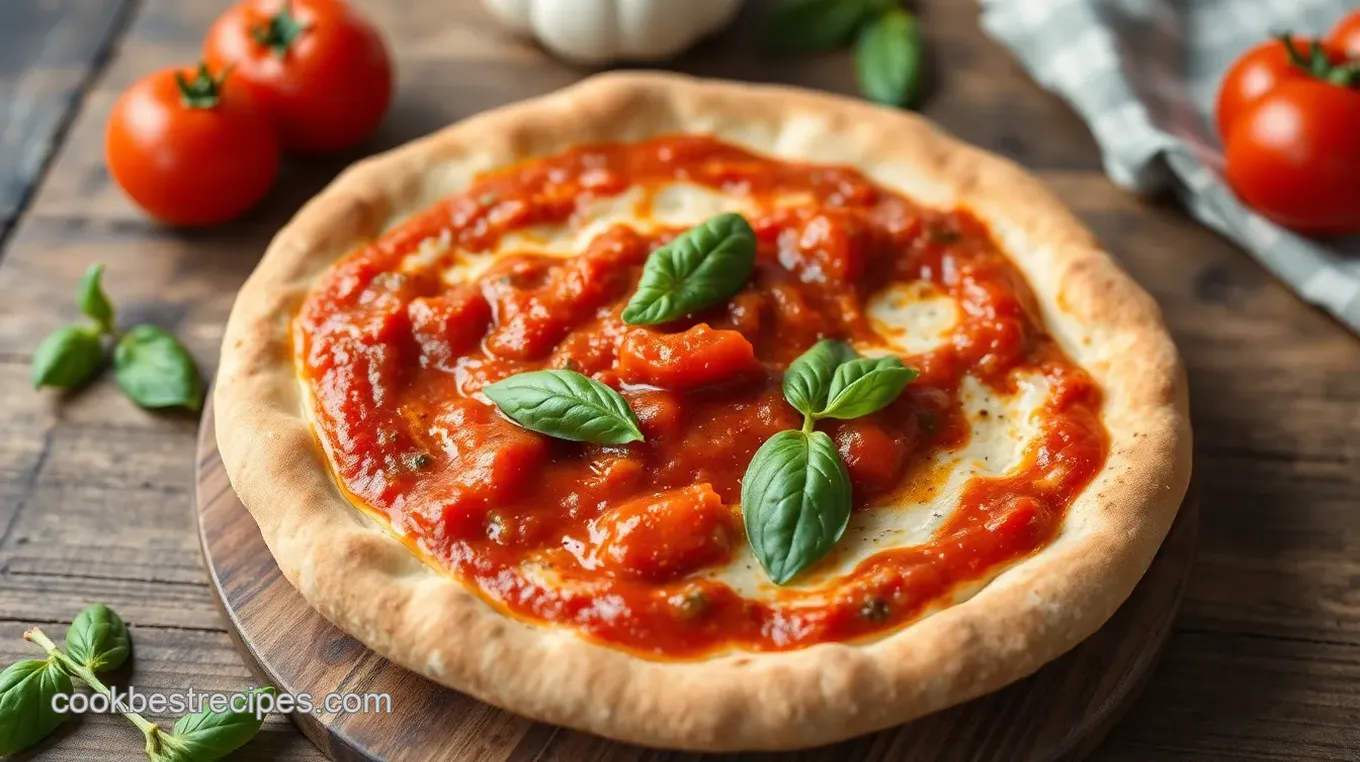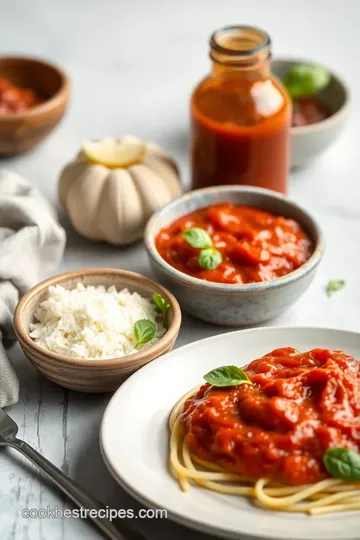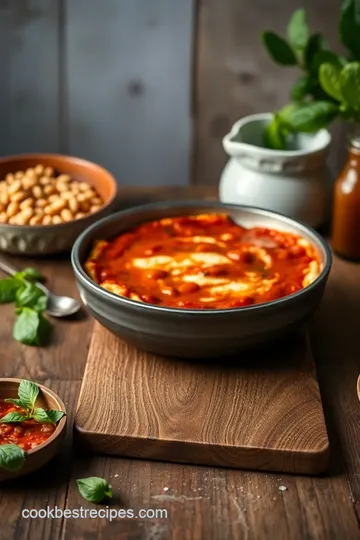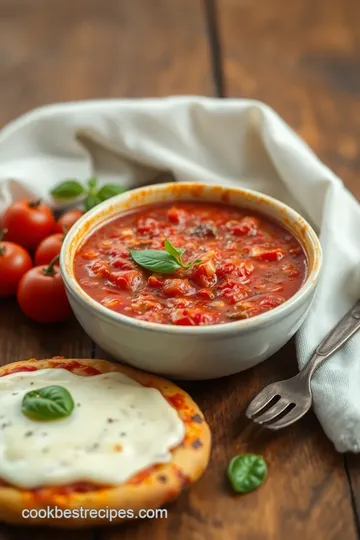Easy Pizza Sauce Recipe in 15 Minutes
Looking for a quick homemade sauce? Try my Easy Pizza Sauce Recipe in 15 Minutes! Its fresh, vibrant flavors will elevate your pizza night. Give it a whirl!

Quick, Flavor-Packed Homemade Pizza Sauce in Just 15 Minutes!
Oh my gosh, let me tell you about the time i tried to whip up a homemade pizza sauce for a little pizza night with my friends.
I can still hear my buddy's laughing when i realized i’d forgotten to grab tomato sauce at the store! but that’s when i discovered my go-to easy pizza sauce recipe in 15 minutes .
Seriously, it changed everything. not only did it save the day, but it also turned our pizza night into a flavor explosion that nobody saw coming.
If you're one who’s tired of the store-bought stuff, stick around. you're gonna love this!
A Slice of History
Pizza sauce is a big deal, especially for us americans! our obsession with pizza really kicked off in the 1900s when italian immigrants brought their culinary traditions over.
But here’s the cool part: making your own sauce isn’t just about nostalgia. nowadays, this quick pizza sauce is a culinary staple, popping up in homes and restaurants everywhere! with just 15 minutes and a blender, you can create a deliciously vibrant homemade sauce that’ll make your pizzas shine.
Recipe Overview
Now, let's lay down the facts. this easy tomato sauce takes only 15 minutes, and guess what? no-cook is the name of the game! just blend and you're golden.
You will need some fresh ingredients, and while there's a tiny bit of time involved, i promise it’s super simple.
Plus, making your own sauce typically costs way less than buying fancy store brands. you can whip up about 2 cups , which is enough for two large pizzas.
Talk about budget-friendly!
Health Benefits & Unique Flavor
Okay, let’s talk benefits. this isn't just fast food; it's good for you, too! packed with vitamin c, antioxidants, and bursting with flavor, this isn’t just any homemade sauce recipe .
It’s a health-conscious option that beats the processed stuff every time. you control what's in it! plus, this sauce is perfect for so many occasions—pizza night, backyard bbqs, or cozy family dinners.
Honestly, what’s more comforting than homemade pizza with your friends?
Homemade marinara is often seen as a time-consuming process, but with this recipe, you get all those enticing italian flavors—garlic, herbs, and tomatoes—without sweating a whole lot in the kitchen.
You can even jazz it up with spicy notes or ramp it down for the kids, making it a perfect family-friendly recipe.
Yes, even picky eaters are on board; it’s that good!
Cutting Down on Prep Time
Now, here's a pro tip: using quality ingredients is key, especially san marzano tomatoes . it makes a huge difference! want to speed things up? double or triple the batch and store extra in the fridge or freezer.
I mean, who doesn’t want a stash of fast pizza sauce ready to go? and if you're feeling adventurous, throw in some fresh basil or oregano.
It's all about customization, you know?
Before i wrap this up, i can’t help but share: if you want an extra kick, throw a pinch of red pepper flakes in there.
Or, if you prefer a milder sauce, keep it classic with just garlic and herbs. the beauty of this sauce lies in its flexibility!
In the next part, we'll dive into the ingredients you’ll need to get rolling. Trust me when I say, you’ll want to keep this recipe close at hand for all your future pizza parties and beyond! Enjoy the process; cooking should be fun, not a chore!
Let’s get ready to make that smooth pizza sauce that’ll wow everyone at the table!

Essential Ingredients Guide for Homemade Pizza Sauce
When it comes to making a mouthwatering pizza that rivals your favorite pizzeria, the secret's in the sauce ! here's your ultimate essential ingredients guide to whip up the best pizza sauce recipe ever, with plenty of helpful tips and tricks along the way.
Trust me, with a few key components, you’ll be ready for pizza night in no time!
Premium Core Components
Let’s kick this off with those must-have ingredients . For our stellar sauce, here’s what you need:
- 1 can (28 oz / 794 g) of whole peeled tomatoes : Go for San Marzano tomatoes when you can. They’re sweeter and richer.
- 2 tablespoons (30 ml) of olive oil : Use extra virgin for the best flavor.
- 3 cloves of garlic, minced : Because garlic is life.
- 1 teaspoon (5 g) of sugar (optional): Balances the acidity.
- 1 teaspoon (5 g) of dried oregano and 1 teaspoon (5 g) of dried basil : Classic Italian flavors!
- ½ teaspoon (3 g) of salt & ¼ teaspoon (1 g) of black pepper : Just the essentials to elevate the flavor.
- ¼ teaspoon (1 g) of red pepper flakes (optional): If you like it spicy!
Freshness Tips
Look for tomatoes that are bright red without any blemishes. If you're picking herbs, fresh is always better.
Signature Seasoning Blend
Now that we’ve got our core ingredients, let’s talk about how to make that sauce sing ! Blending your herbs and spices is essential.
Use a combination of dried and fresh herbs to create various nuances in flavor. remember, oregano and basil always play well together.
If you’re feeling adventurous, you can toss in a sprinkle of italian seasoning for an extra flavor boost.
Flavor Enhancers & Aromatics
Adding fresh garlic instead of powdered garlic could transform your sauce from good to absolutely scrumptious ! you might also try adding a splash of lemon juice or vinegar for a zesty kick! just think about the enticing italian flavors you can create.
Smart Substitutions
Sometimes life doesn’t play fair, and you might run out of an ingredient. No worries, here’s where we get smart !
- Crushed tomatoes can replace whole peeled tomatoes in a pinch.
- If you're out of oregano or basil? Sub in thyme or parsley as a fresh alternative.
- Need a vegan pizza sauce ? This recipe is already vegan-friendly, so you’re all set!
Kitchen Equipment Essentials
Alright, let’s make sure you have the right kitchen tools for pizza sauce . Here’s what you should grab:
- Blender or food processor : This is key for that smooth pizza sauce.
- Measuring cups and spoons : Don’t wing it; measuring ensures consistency.
- Mixing bowl : In case you want to taste and adjust your flavors as you blend!
Preparation Tips
Avoid the urge to blend too long; a quick blitz will give you that smooth pizza sauce without overdoing it!
Serving and Storing Your Sauce
Got your sauce made? it’s time to enjoy! this easy pizza sauce recipe in 15 minutes makes about 2 cups .
Perfect for two large pizzas or plenty for pizza night parties!
If you find yourself with leftovers (though, seriously, how could you?), store your sauce in an airtight container in the fridge.
It should be good for about a week. you can also freeze it, so you’re just a thaw away from another homemade pizza night!
Tips for A Fantastic Pizza Night
Why not pair this homemade sauce recipe with fresh ingredients for pizza toppings ? think veggies, fresh mozzarella, or even a drizzle of garlic pizza sauce for an extra layer of flavor.
You’ll wow your friends and family, making this a regular on your dinner table.
So, buckle up, pizza lovers! with this essential ingredients guide , you’re ready to dive into the delicious world of homemade pizza sauce.
And trust me, it's not just a sauce; it’s the heart of your pizza experience.
Next, let’s roll up our sleeves and dive into the step-by-step instructions for making this easy tomato sauce come to life!
Mastering the Professional Cooking Method: Your Guide to Easy Cooking
When it comes to cooking professionally—or just whipping up something fab for pizza night—you gotta know a few key steps to make your life easier.
Let’s break it down into bite-sized pieces. whether you're craving a homemade pizza or just want to nail that "easy pizza sauce recipe in 15 minutes," getting the hang of professional cooking methods can change the game!
Essential Preparation Steps
Mise en Place: Your Best Friend
First things first, if you want to cook like a pro, learn the mise en place method. it’s the fancy french term for having all your ingredients prepped and organized.
Chop that garlic, measure your olive oil, and open those canned tomatoes. when everything is ready to go, cooking feels like a breeze.
Time Management Tips
Timing is everything—especially when that pizza dough is rising and you’re ready to slather on your 15 minute sauce . set a timer for each step! i can't tell you how many times i've burned something because i got distracted.
Keep it simple: prep, cook, and serve.
Organization Strategies
Keep your workspace tidy. if you’re a werewolf in the kitchen (you know, the kind that leaves a wake of chaos), take a moment to declutter.
A little organization goes a long way.
Safety Considerations
Now, let’s talk safety. Always have a cutting board that won’t slide around, and keep those knives sharp—don’t go hurting yourself while trying to slice onions!
Step-by-Step Process for Quick Cooking
- Prep Your Ingredients: Gather everything on your counter—the canned tomatoes, herbs, spices, and tools you’ll need.
- Open That Can: Seriously, get that can of whole peeled tomatoes ready because that’s where the magic starts.
- Blend Away: Toss everything into your blender. Hit that high-speed button and watch a smooth pizza sauce form under your eyes.
- Taste Test: Don’t skip this! Adjust seasonings. A dash of salt or more garlic can make it pop.
- Store It Right or Use It Fresh: If you make too much, pop it in the fridge for a week of no-cook pizza sauce bliss.
Expert Techniques Anyone Can Master
Professional Methods
Use high-quality ingredients, like San Marzano tomatoes , for a real flavor booster. This isn’t just any homemade sauce recipe ; it’s the kind that could make you the pizza Picasso among your friends!
Critical Steps Explained
Remember, blending until smooth gives you that restaurant-quality smooth pizza sauce vibe. If you’re feeling adventurous, blend for less time to leave it a bit chunky—just like my grandma used to make.
Quality Checkpoints
Always check consistency. If your sauce is too runny, add a touch of tomato paste. Instant fix!
Troubleshooting Tips
If your sauce tastes a bit flat, sprinkle in a pinch more of that dried oregano or some red pepper flakes—the magic spices of Italian cuisine!
Success Strategies to Elevate Your Cooking Game
Common Mistakes to Avoid
Over-blending can take away texture. Don’t do it! Also, skimping on taste tests can lead to unexpected heartbreaks—like bland pizza.
Quality Assurance Tips
Take the time to make adjustments. Real cooking is about experimenting, so don’t rush it.
Perfect Results Guide
Remember those classic marinara strains—let your pizzas shine with vibrant flavors!
Make-Ahead Options
Want to be a dinner hero? Whip up a double batch of your easy tomato sauce and freeze half. You’ll thank yourself on those busy weeknights.
Wrap-Up and Transition to More Deliciousness
By mastering these easy techniques in the kitchen, you're just a few steps away from becoming the pizza connoisseur of your circle.
And honestly, who doesn't want that? next up, we'll dive into additional information that'll take your pizza-making to a whole new level—get ready to explore more variations like spicy pizza sauce or vegan pizza sauce! don’t forget: that easy pizza sauce recipe is just the start of your culinary adventure.
Happy cooking!

Pro Tips & Secrets
Alright, pizza fanatics! let’s dive into some pro tips for whipping up your easy pizza sauce recipe in 15 minutes .
First off, use quality tomatoes . seriously, splurge a bit and grab some san marzano tomatoes . they make a world of difference; trust me.
If you want a stickier sauce, blend just until mixed, and leave some chunks for that rustic feel.
Now, onto time-saving techniques : you can make a double batch and freeze half! pizza night is gonna look so good next week! also, throw in a splash of balsamic vinegar or even a dollop of pesto for a unique twist.
Don’t forget to taste test and adjust those seasonings like a boss – a little extra oregano could be the magic touch!
Perfect Presentation
Let’s talk about presentation . presentation can take a meal from a “meh” to “whoa!” use a white plate to really show off that bright red sauce.
For garnish, a sprinkle of fresh basil or a drizzle of olive oil goes a long way. it’s like saying, “look how fancy i am!” plus, don’t forget the color – vibrant colors are like a feast for the eyes!
Storage & Make-Ahead
What if i told you that you can save that incredible sauce for later? yup! this no-cook pizza sauce stays fresh in an airtight container in the fridge for about a week.
If you freeze it? it could last up to three months . just remember to thaw it in the fridge overnight before using.
When it comes to reheating, just pop it in a saucepan for a couple of minutes on low heat until warm.
That’s it! no burning or fussing – because who has time for that?
Creative Variations
Let’s unleash some creativity! you can make this sauce your own! how about a spicy pizza sauce ? just add more red pepper flakes or even some jalapeños .
Also, feel free to switch things up for dietary needs! want a vegan pizza sauce ? you’ve got it, no modifications needed! just focus on fresh ingredients, and you’re all set.
Seasonal twists? Absolutely! In summer, toss in some fresh diced tomatoes for that bright, juicy flavor. And don’t get me started on regional variations ! How about channeling a classic Italian pizza sauce by adding a pinch of fresh garlic before it hits that blender?
Complete Nutrition Guide
Let’s chat numbers without going all math geek on you. this sauce clocks in around 70 calories per serving. with 1 gram of protein and only 4.
5 grams of fat , you can enjoy pizza without the guilt. plus, it’s packed with fibers from those juicy tomatoes.
If you’re watching carbs, this easy homemade sauce makes for a great healthy alternative.
When you serve it, stick to about ½ cup per pizza . That's the sweet spot for flavor without going overboard.
Expert FAQ Solutions
I know you have questions about that sauce. Like, can you customize it? Of course! Interested in a garlic pizza sauce ? Just ramp up the garlic!
What if it’s too thick? add a splash of water or some olive oil to smooth it out. and if you made it too spicy, fear not – a spoonful of sugar can balance those flavors.
Did someone say, “How do I do this faster?” Use kitchen tools for pizza sauce like a blender or food processor – it saves time and gives you that velvety smooth texture.
Conclusion
So there you go, my amigos! the easy pizza sauce recipe in 15 minutes is not just about slapping together ingredients; it’s about creativity, love, and flavor.
Whether it’s for a casual pizza night or a fancy date, this sauce will impress and leave you craving more.
So, what are you waiting for? Get your aprons on and give this delicious, homemade marinara a try! Your future pizza-loving self will thank you!

Easy Pizza Sauce Recipe in 15 Minutes Card

⚖️ Ingredients:
- 1 can (28 oz / 794 g) whole peeled tomatoes
- 2 tablespoons (30 ml) olive oil
- 3 cloves garlic, minced
- 1 teaspoon (5 g) sugar (optional, to taste)
- 1 teaspoon (5 g) dried oregano
- 1 teaspoon (5 g) dried basil
- ½ teaspoon (3 g) salt
- ¼ teaspoon (1 g) black pepper
- ¼ teaspoon (1 g) red pepper flakes (optional, for heat)
🥄 Instructions:
- Step 1: Gather all ingredients and equipment.
- Step 2: Pour the can of whole peeled tomatoes into the blender.
- Step 3: Add olive oil, minced garlic, sugar (if using), oregano, basil, salt, black pepper, and red pepper flakes to the blender.
- Step 4: Blend on high speed until the sauce reaches a smooth consistency.
- Step 5: After blending, taste the sauce and adjust seasoning as needed.
- Step 6: Either use the sauce immediately on your pizza or store it in an airtight container in the refrigerator for up to one week.
Previous Recipe: How to Bake Deep-Dish Pizza with Cheesy Goodness: 10 Delicious Tips
Next Recipe: How to Make Sautéed Shrimp in Creamy Lemon Sauce: A Delicious Weeknight Favorite
